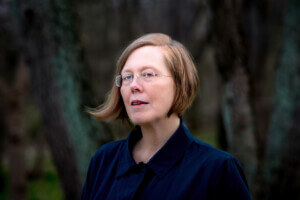Nearly 16 years ago, Professor Ovaska introduced me, as a teaching assistant on a summer studio road trip, to a wide range of architecture and landscapes across the U.S. On March 19, I revisited my favorite, Craters of the Moon National Park. On March 26, we lost Arthur.
The “Moebius Trip” departed Ithaca, NY to criss-cross the country in a figure eight, which sometimes seemed to last for infinity. The nation’s endless highways, expansive landscapes, and varied architecture—historical and contemporary, vernacular and uncommon, even eccentric (yes, I’m thinking of House on the Rock)—stretched out before us. The stops, often hot and crowded as tourist season hit its peak, were the slideshows with brief captions; the three minivans were the classrooms for discussion. My winter visit was rather serene as I looked across the snow-capped volcanic rock, the whistling high desert wind the only sound, reflecting on Ovaska’s course.
After he received his Bachelor of Architecture in 1974, Ovaska taught at Cornell University for more than thirty years as an associate professor of architecture. While he began his graduate studies that same year, studying under O. M. Ungers, he spent the next four years collaborating on projects, including “The City in the City: Berlin, A Green Archipelago,” (1977) a manifesto by Ungers and Rem Koolhaas. The project focused on Berlin as a series of interventions with city planning in symbiosis with architectural form, a theme Ovaska would pursue the rest of his life. In 1978, Ovaska went on to co-found Kollhoff & Ovaska, a firm in Berlin, with fellow collaborator Hans Kollhoff. Their most recognized design was the master site plan for the International Building Exhibition Berlin in 1987.
In 1987, Ovaska accepted a teaching position at his alma mater where he became director of undergraduate studies, director of graduate studies, and chair of the Department of Architecture. Ovaska contributed an article, “States of Emergence: Place in a Post-Guru Context,” to The Cornell Journal of Architecture #4, “States of Emergence: Place in a Post-Guru Context,” where he—a man of few but poignant words—succinctly summarized his pedagogical approach: “difficult to grasp for the student who sees ink-on-mylar as the end product of a problem. These projects attempt to conceive of place as the medium in which the Architect works and from which ideas emerge. ”
He had a sense of humor, even after he was diagnosed with cancer in 2016, posting on Facebook an image of his head collaged on a medical illustration showing which parts of his body were to be removed in an upcoming surgery and another on the body of Dr. Frankenstein; obituaries for Fats Domino, Wilbur Post, and his colleague Bonnie MacDougall, and a plan of Alvar Aalto’s Malmi Funeral Chapel. But rather than dwell on his own mortality, Arthur continued to seek the nuanced and unique in architectural anomalies, obscure drawings, and provocative (not sensational) design.
He was 67 when he died at home in Ithaca.











